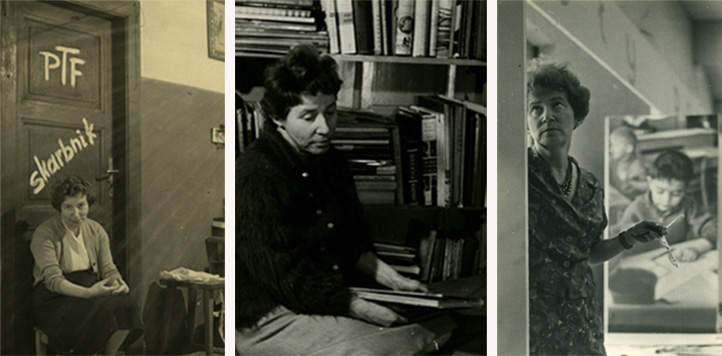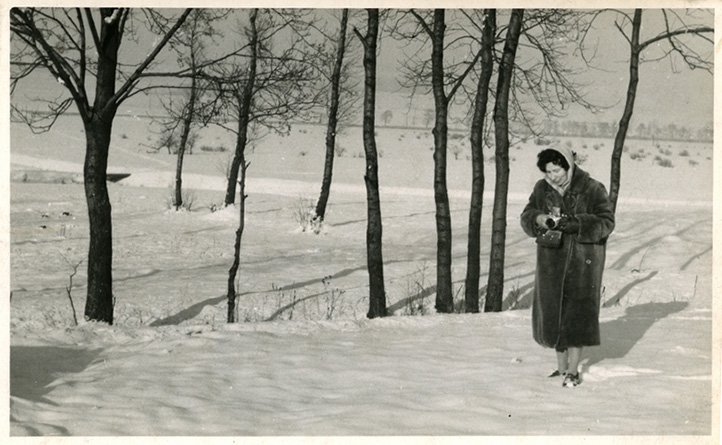Documentations (1950-1978)
The collection of Zofia Rydet’s photographs grouped under the umbrella title Documentations 1950–1978 covers the earliest part of the artist’s output. It consists of over thirty thousand pictures, taken in Poland and abroad, some existing as prints and others only as negatives.
 Zofia Rydet, 1960s. Author unknown
Zofia Rydet, 1960s. Author unknown
The negatives were ordered by Rydet herself according to where the images were made—for example Rabka, the Gliwice area, and the Nowy Sącz area—and according to specific topics such as culture parks, universities, and television. From the very start of her photographic project, her theme was man in various situations and at various stages of life. Children are frequent protagonists: their portraits, relationships, and games and activities are the basis of her cycle Little Man. Another cycle, Time of Passing, is devoted to old age and death.
Documentations also portrays specific social or professional groups: students (the University cycle, intended for publication under the same title); actors and dancers, for example from the Bytom Opera; factories and their equipment and workers; mines and miners; the Opole Song Festival; and so on. An important theme of Rydet’s early photographs is gatherings of people, such as the crowds at Labor Day parades and other celebrations from communist times, spectators at a football game, theatre or concert audiences, and groups of people on beaches and in parks.
Another theme is the city, especially small provincial towns: their representative places, but above all their hinterlands and peripheries: timber or coal storage spaces, gloomy courtyards, nooks and crannies of old buildings; everyday situations among inhabitants, children playing among bricks and concrete. Bytom at the beginning of the 1960s, for instance, is portrayed in this way.
But perhaps the theme most represented in Documentations is landscape and nature. Rydet loved open spaces, fields, and meadows, and documented them in all seasons. She made hundreds of photos in woods and parks, often persistently portraying individual trees.
From the very start, the artist separated her photographs into envelopes arranged by visual motif: clouds, trees, roots, roads, fences, walls, textures, structures, mirrors, pairs of humans—such as a child and an elderly person, in an envelope marked CONTRASTS. From these collections she drew elements for her later collages.
In her Bytom era, Rydet lived on a high floor, and from there she watched and photographed her surroundings. The “from above” perspective, characteristic of avant-garde photography, was a technique she used very often. We see rooftops, people in the street, geometric ornaments on pavement, lines painted on the road, flat outlines of parapets, benches, puddles, streaks of snow.
Thanks to their thematic and geographical variety, the images in Documentations provide a picture of Poland under communism—of picturesque rural poverty and tradition, the lifestyle and fashion of the socialist cities, the glitz of anniversary parades. At the same time, we can observe how Rydet’s sensitivity and photographic skill developed, discovering the processes behind such cycles as Little Man, Time of Passing, The World of Feelings and Imagination, The Infinity of Distant Roads, and finally The Sociological Record.
In 2016, as part of a grant from the Ministry of Culture and National Heritage, the Zofia Rydet Foundation published the first part of the Documentations collection online: 2,400 scanned negatives of photos taken in Rabka and surrounding areas, as well as in Opole, Chorzów (culture parks), Bytom, and Czeladź. In 2017, over five thousand more photographs from the collection were made available, mainly photographs from Silesia embracing Katowice (including Pałac Młodzieży), Gliwice (universities such as the Polytechnic School, Academy of Music, Medical Academy, Academy of Fine Arts, Economic University, and Pedagogical University, in addition to the city itself), the area around Gliwice (Bojków, Bojszów, Brzezinka, Bycina, Dzierżno, Gierałtowice, Kozłów, Nieborowice, Poniszowice, Rudziniec, Sierakowice, Smolnica, Sośnica, Sośnicowice, Trachy, Tworóg, Wilcza, Wilcze Gardło, Żernica), and Bytom (including photos from the Little Man cycle) and its suburbs, Dąbrowa Górnicza (the ELDOM factory) and Myszków (a paper mill).
In 2018, 6,650 photographs from the remaining negatives of the Documentations 1950–1978 collection were archived and digitized. These included portfolios from the Beskid Mountains, Kujawy and Pomerania, Masuria, Orava, the Pieniny, Podhale, Spisz (Spiš), the Nowy Sącz region, and Silesia and Opole Silesia, as well as the cities Częstochowa, Kraków, Krosno, Poznań, Toruń, and Włocławek, and numerous surrounding towns and villages. Posting these photographs on the website completes the archiving, digitization, and preparation of those photographs from the Documentation collection that were taken in Poland. The Foundation team is currently working on raising funds for the development of photographs taken abroad in many European countries, as well as in Libya and Egypt.
 Zofia Rydet, 1960s. Author unknown
Zofia Rydet, 1960s. Author unknown